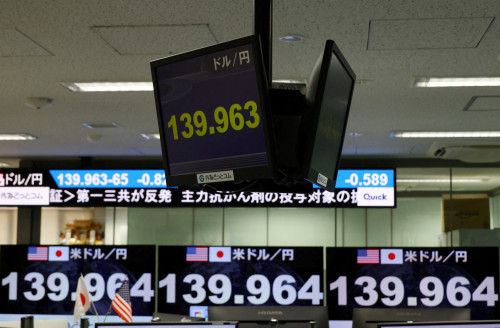By Shankar Ramakrishnan, Davide Barbuscia, Saeed Azhar and Laura Matthews
(Reuters) – Good news of a tentative deal for the U.S. debt ceiling impasse may quickly turn out to be bad news for financial markets.
U.S. President Joe Biden and top congressional Republican Kevin McCarthy on Saturday reached a tentative deal to raise the federal government’s $31.4 trillion debt ceiling, two sources familiar with the negotiations said, potentially averting an economically destabilizing default.
But the deal still faces a difficult path to pass through Congress before the government runs out of money to pay its debts in early June.
“This will be pretty good for the market,” said Amo Sahota, director at KlarityFX, adding that it may give more reason for the U.S. Federal Reserve to feel confident about raising rates again.
“Although we want to see what the … deal looks like,” Sahota added.
While an end to uncertainty would be welcome, the relief that may come from a deal may be a short-lived sugar high for investors. That’s because once a deal is reached, the U.S. Treasury is expected to quickly refill its empty coffers with bond issuance, sucking out hundreds of billions of dollars of cash from the market.
The raising of ceiling is expected to be followed by the issuance of nearly $1.1 trillion in new Treasury bills (T-bills) over the next seven months, according to recent JPMorgan estimates, a relatively large amount for that short a period.
This bond issuance, presumably at the current high interest rates, is seen depleting banks’ reserves, as deposits held by private companies and others move to higher paying and relatively more secure government debt.
That would accentuate an already prevalent trend of deposit outflows, put more pressure on liquidity, or ready cash, available to banks, push up rates charged on near-term loans and bonds, and make funding more expensive for companies already reeling under a high interest rate environment.
“There is certainly going to be a relief in the fixed income markets,” said Thierry Wizman, global FX and interest rates strategist at Macquarie.
“But what this doesn’t solve, is that along the whole Treasury curve yields have gone up recently… in anticipation that there will be a lot of issuance of treasury bonds and notes and bills in the next few weeks because the U.S. Treasury has to replenish its cash.”
A BNP strategist estimated some $750 billion to $800 billion could move out of cash-like instruments, such as bank deposits and overnight funding trades with the Fed. That decline in dollar liquidity will get used to buy $800 billion to $850 billion in T-bills by the end of September.
“Our concern is that if liquidity starts leaving the system, for whatever reason, this creates an environment where markets are crash prone,” said Alex Lennard, investment director at global asset manager Ruffer. “That’s where the debt ceiling matters.”
Mike Wilson, equity strategist at Morgan Stanley, agreed. Treasury bills issuance “will effectively suck a bunch of liquidity out of the marketplace, and may serve as the catalyst for the correction we have been forecasting,” he said.
The drain on liquidity is not a given, however. The T-bill issuance could be partly absorbed by money market mutual funds, shifting away from the overnight reverse repo facility, where market players lend overnight cash to the Fed in exchange for Treasuries.
In that case, “the impact on broader financial markets would likely be relatively muted,” Daniel Krieter, director of fixed income strategy, BMO Capital Markets, said in a report.
The alternative, where the liquidity drain comes from banks’ reserves, “could have a more measurable impact on risk assets, particularly at a time of elevated uncertainty in the financial sector,” he added.
Some bankers said they fear financial markets may not have accounted for the risk of a liquidity drain from banks’ reserves.
The S&P 500 has gained handsomely through the year while spreads on investment-grade and junk bonds have either tightened or only marginally widened from January.
“Risk assets have likely not fully priced in the potential impact of the tightening of liquidity in the system through an abundance of T-bill issuance,” said Scott Schulte, a managing director in Citigroup’s debt capital markets group.
Bankers put it to hope that the debt ceiling impasse would be resolved without significant dislocation to markets, but warn that’s a risky strategy.
“Credit markets are pricing in a resolution in Washington, so if that is not delivered by early next week, we are likely to see some volatility,” said Maureen O’Connor, global head of high-grade debt syndicate at Wells Fargo.
“That said, many investment-grade companies preempted this risk which is why we saw such an active May calendar,” she added.
(Reporting by Shankar Ramakrishnan, Saeed Azhar, Davide Barbuscia and Laura Matthews; editing by Paritosh Bansal, Megan Davies and Kim Coghill)









